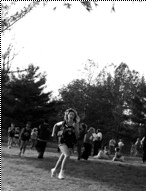My first foray into running was when I decided to join the Athletics team for the Houghton Lake Bobcats in my freshman year. I have to laugh now when I think of that brutal introduction! I couldn’t run. Honestly, I couldn’t. I had no conception of pace, of timing, of training or of fitness. I had assumed that I was fit, being young and full of energy, but after my first training session, I knew differently. The first year was interesting. I ran the two mile and the eight hundred as part of the two mile relay, as well as occasionally running the mile. I never placed, and I distinctly remember not finishing my first race with two laps to go, I just lost my legs and could not finish.

Fall “89 Melissa in full flight at a Cross-Country Conference Meet. Photo Courtesy of Melissa Wallace.
Even though it was a dismal beginning, I volunteered for the Cross Country team at the beginning of my sophomore year of high school. There were ten lads and one girl other then myself. For training, we would head out on long runs of up to five miles, at a pace we could handle. Once we had a week or two of this, our coach would introduce hill runs and sand runs. Needless to say, I had a dismal year in Cross Country, and thought during every race that I was being tortured (by myself). I have to add at this point, that the coach Byron Townsend, never discouraged me in any way, and repeatedly praised any improvement I made, even if it was only to actually finish the workout. By the time my first season ended, I was proud of the fact that I had been able to run the whole of my last five races without stopping to walk in the middle of them.
My second season of athletics was a revelation. I figured out how to run. I don’t remember exactly when it happened, or how, but I do remember the feeling of settling into a pace, of pushing through the barrier, and of reaching that place in my own mind and body where it felt natural and exhilarating to push myself. The torture I thought I endured in training was no longer the same kind of torture, and I began to actively participate in my own development as a runner. It was at this time that I began to take note of what we were actually trying to do at training, and to work with my coach and team mates in developing my weak areas and discovering what I could and couldn’t do.
The coach would meet us on the road stretches and introduce fartlegs, which to the uninitiated are runs that are performed at different speeds. We would run at three quarter speed for one minute, then jog for two, revert to three quarter again for two minutes, jog for three, and so on. The purpose of this was to develop both our racing pace and our recovery time. As the season developed, we would have to run longer at the fast pace, with the shorter interval at the slow in order to develop our stamina. He would also meet us at the foot of a particular hill, which was three hundred and fifty metres at a steep grade. We would have to do up to ten sets of the hill as fast as we could, walking or jogging slowly back down to the base. (That was definitely torture of the highest degree). Every other day we would train on the track. This was specifically for speed and pacing purposes. We would run fartlegs on the track. At the beginning of the season, we were asked to do these at three quarter pace on the straight and jogging on the bends, but by the end of the season this was up to full speed on the straights, and slow on the bends.
The sprinters would join us for this work out, and as a distance runner at the time, this helped improve speed greatly! We couldn’t possibly let them out run us over a distance, so we pushed ourselves to try to keep with them on the fast bits so that we weren’t too far behind on the bends. The only difference between us in the end was that they were faster, but we could do more laps. Thank God we never did more then a mile of this at a time, as it was arduous. At times there were people who just couldn’t do it all, and we all had those days, myself included. Our workouts also included mile long runs at a set pace per lap, increasing the speed with each lap, and running laps backwards to reduce the strain on our shins. As not all of the tracks that we ran on were of modern surfaces (there were still one or two ash tracks, and some that were old and crumbling; the original surface baked as hard as glass by the hot sun, and subsequently cracked by the cold in the winter) the majority of us tended to suffer shin splints, on and off, throughout the year.
Remembered and written by Melissa Wallace.
Melissa Wallace is a permanent resident of the village of Tullycross, on the Renvyle Peninsula, in the Parish of Letterfrack- Ballinakill.
Full Version Available in “Pride in the Parish: Volume 1”

